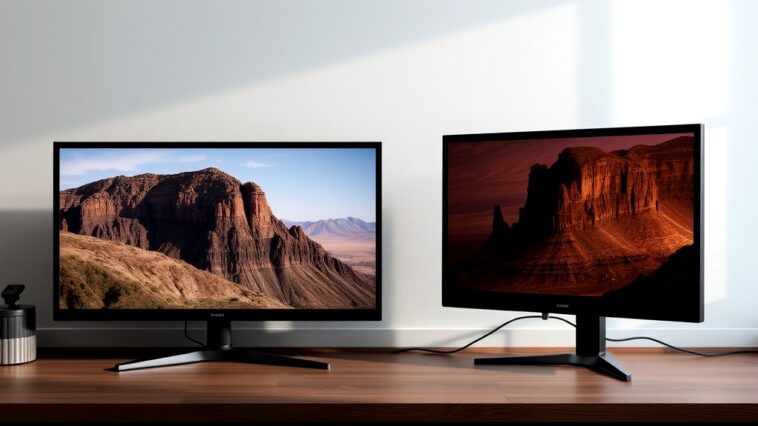So, you’ve been shopping around, and you’ve probably noticed something odd: computer monitors often carry a heftier price tag than televisions. At first glance, this might seem counterintuitive. After all, can’t you just get a big-screen TV and hook it up to your computer? Sure, you can, but there’s much more to it than meets the eye. Let’s dive into the nitty-gritty of this pricing dilemma, exploring the differences in technology between computer monitors and TVs, among other factors that contribute to their costs.
The Tech Under the Hood
Differences in Technology Between Computer Monitors and TVs
To understand why monitors are pricier, we first need to look at the display technology used. Computer monitors often utilize advanced technologies such as IPS (In-Plane Switching) and TN (Twisted Nematic), which specialize in color accuracy and response time. This makes them ideal for graphic design, gaming, and other high-precision work where clarity and color reproduction matter.
Conversely, TVs are designed primarily for viewing from a distance, which calls for different specs. The emphasis is on larger screen sizes and viewing angles, but not necessarily on color accuracy. So, when you’re paying for a monitor, you’re investing in top-notch tech that caters to specific, demanding uses.
Cost Factors Influencing Computer Monitor Pricing Compared to TVs
But what about the price tags? Well, various cost factors come into play. For starters, the production of high-quality panels—especially those with high resolutions like 4K and 8K—requires expensive materials and technology. Additionally, monitors often have better build quality and durability, which can further inflate the price.
Why High-Resolution Computer Monitors Are Pricier Than Standard TVs
You may have noticed that some monitors are marketed as “high-resolution.” This isn’t just a marketing gimmick. Monitors with resolutions of 1440p, 4K, or even 8K are optimized for close-up viewing, producing sharper images that are essential for tasks like photo editing or gaming. In comparison, most standard TVs might offer 4K but are often tuned for general viewing, not for the pixel-perfect needs of professionals. So, if you want a monitor that can handle high-resolution tasks, expect to pay a premium.
Importance of Color Accuracy in Computer Monitors Versus TVs
Now let’s talk about color accuracy—something that’s often overlooked. For monitors, color fidelity is crucial; professionals in graphic design and photography rely on accurate color reproduction. This is why many high-end monitors come factory-calibrated. TVs, on the other hand, are usually set to deliver vibrant colors that look good on the couch, often at the expense of accuracy. This difference in focus on color quality can make monitors significantly more expensive.
Refresh Rates and Performance
The Impact of Refresh Rates on Monitor and TV Pricing
Ever wonder why gamers are so obsessed with refresh rates? Well, a higher refresh rate means smoother motion and less blurring, which is critical for gaming experiences. Monitors often come with refresh rates that can reach up to 240Hz, while most TVs hover around 60Hz to 120Hz. This difference not only impacts performance but also plays a role in the pricing of monitors. Higher refresh rates require more advanced technology, contributing to the cost.
Panel Technology and Its Effects
How Display Panel Technology Affects Monitor and TV Costs
The type of display panel technology used is also a game-changer in price. Monitors frequently employ IPS or VA (Vertical Alignment) panels, which provide better color reproduction and viewing angles. These panels come at a higher production cost compared to the TN panels often found in lower-end TVs. In simpler terms, you’re paying for the premium experience that a good monitor provides.
Features That Justify Higher Prices
Monitor Features That Justify Higher Prices Compared to TVs
When it comes to features, monitors usually come packed with functionalities that justify their higher price. Features like adjustable stands, built-in blue light filters, and specialized ports (like USB-C for charging) are common in monitors but rare in TVs. These add-ons may seem trivial but reflect a focus on utility and comfort—factors that can drive up the cost.
Comparing the Longevity of Computer Monitors to Televisions
But it’s not just about upfront costs; let’s think long-term. Longevity is another factor to consider. Monitors designed for heavy use, like those in professional environments, often come with warranties and durability features that outshine typical TVs. So, while you might spend more on a monitor initially, its lifespan could make it more cost-effective over time.
The Business Perspective
Why Business-Class Monitors Are More Expensive Than Consumer TVs
If you’ve ever looked at business-class monitors, you might’ve gasped at the price. These monitors are built to withstand constant use and are often calibrated for specific tasks, making them invaluable in professional settings. TVs? They’re built for entertainment, not enduring the rigors of daily office use. This distinction often leads to a significant price gap.
The Role of Connectivity Options in Monitor and TV Pricing
Let’s not forget connectivity. Monitors usually come with a variety of ports—HDMI, DisplayPort, USB-C, and even legacy connections like VGA. This versatility is essential for professionals who need to connect multiple devices. Meanwhile, TVs might have HDMI ports, but they often lack the range of connectivity options necessary for a versatile workspace, which can make monitors more expensive.
Gaming Monitors vs. TVs
Why Professional Gaming Monitors Cost More Than TVs
For gamers, the stakes are even higher. Professional gaming monitors often come equipped with features like G-Sync or FreeSync, which reduce screen tearing and ensure smooth gameplay. These technologies require advanced engineering and increased costs. TVs, while getting better for gaming, usually don’t meet the same performance standards, which explains why gaming monitors can be significantly more expensive.
Understanding Warranty Differences Between Monitors and TVs
When considering a purchase, warranty matters. Monitors generally come with longer and more comprehensive warranty plans than TVs. This can be a significant cost factor, as the warranty reflects the manufacturer’s confidence in their product’s durability and performance.
Ergonomics and Usage Context
The Value of Ergonomics in Monitors Versus TVs and Pricing
Ergonomics play a major role in monitor pricing. Many monitors are designed with adjustable stands and features that promote comfortable viewing angles, which is especially important for those who spend long hours in front of a screen. TVs, designed for casual viewing from a distance, may not offer these options, making monitors a pricier but more comfortable choice.
How Usage Context Influences the Price of Monitors Compared to TVs
The context in which a display will be used also drives pricing. Monitors are often designed for specific professional applications, such as graphic design or medical imaging, where performance and precision matter. TVs, meant for general entertainment, don’t have the same level of specialized design, which can contribute to the lower price.
The Price of Innovation
Why OLED Monitors Are Generally More Expensive Than LED TVs
Now let’s talk about the cutting edge—OLED technology. While OLED TVs have gained a lot of traction, OLED monitors are still more expensive due to the advanced technology required to produce them. They provide unparalleled color and contrast but come with a price tag that reflects their premium nature. LED TVs, while great, simply can’t match the performance of OLED monitors.
Conclusion: What’s the Bottom Line?
At the end of the day, the pricing difference between computer monitors and TVs can be attributed to a complex mix of technology, features, and intended use. Monitors are designed with precision and professional needs in mind, making them more expensive but often worth the investment. So, if you’re in the market for a display, weigh your options carefully—consider what you’ll be using it for and whether the higher cost of a monitor is justified for your needs.
Honestly, I think that understanding these factors can make your purchasing decision a lot easier. After all, you don’t want to end up with a big TV that doesn’t meet your professional needs, right? You want a display that works for you!




